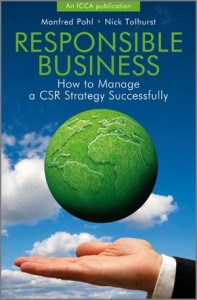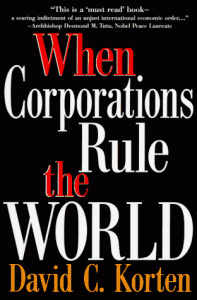14 February 2010
Well, I’ve been in Melbourne a couple of days now – finally over the jetlag. The flight from London via Hong Kong is a bit of a marathon, and with an 11 hour time difference, it’s not surprising my body clock was confused.
I am staying in a student complex, about 30 minutes outside the city, and about 15 minutes from the La Trobe campus. It’s a matchbox size single room with a bed, sink and toilet/shower (the toilet is actually inthe shower cubicle!). What more does a guy need?
I’ve had two short trips into the city. First, on Thursday, I visited Leeora Black, Director of ACCSR, and took a lovely stroll through the Royal Botanical Gardens. There’s some great, funky architecture down town. Friday was just a quick trip in to apply for a passport renewal.
Friday to Sunday, I was teaching at La Trobe Graduate School of Management – the first half of a 6 day module on Business in Society, as part of a Masters in Responsible Business. They are a great bunch of students – a mixture of managers, local government officials and academics.
The La Trobe campus is vast, with large expanses of green space. I keep seeing “beware of the kangaroo” signs, but I haven’t seen any yet (maybe they can’t read?). There is a nature reserve right next to the campus, which I look forward to visiting.
Today, I head off to Sydney for a couple of days, where I will be teaching a 1-day workshop for the University of New South Wales on “Creating Change through Social Responsibility”. I should have a day or so to be a city tourist as well, before heading back to Melbourne.
I’ll be staying in Bondi with Samantha Graham, an old friend who studied with me at the Centre for Human Ecology in Edinburgh about 15 years ago. She is now a mum & sustainability educator at Stormlight Consulting. It’s great how these connections live on over time and space.
18 February 2010
This week, I flew to Sydney to deliver a workshop on “Creating Change through Social Responsibility” for the University of New South Wales’ Centre for Social Impact. I also gave a talk on “The Future of CSR” at a CSR Sydney evening event, kindly hosted by David Morrisey.
I was fortunate enough to be given a place to crash for 3 nights by Samantha Graham, a colleague from my days at the Centre for Human Ecology in Edinburgh, where we both did our Masters. Both Sam and her partner, John Talbott, also lived at the Findhorn Community for many years.
Findhorn is an ecovillage in the north of Scotland, which I visited twice (in 1994 and 1995). It was a source of great inspiration, as an example of living in harmony with nature and with an intentional spiritual purpose. Like so many others, I first heard about it through Paul Hawken’s book, The Magic of Findhorn – the same Hawken who wrote subsequent classics that have been equally leading-edge, like The Ecology of Commerce, Natural Capitalism and Blessed Unrest.
As it happens, Sam & John’s flat overlooks Bondi Beach, so I was treated not only to their wonderful hospitality, but also spectacular views across the bay.
On my “tourist day”, I visited the New South Wales Art Gallery, where I was most taken with the Aboriginal art painted on flattened bark. There is also a fantastic sculpture outside, comprised of two 20 ft matches – one burned and the other not. Apparently, it is a commentary by the artist of the transience of life.
I also walked around Darling Harbour and took the ferry to Manly, which allows great views of Sydney Harbour Bridge and the Opera House. All in all, my impressions of Sydney (which has strong echoes of Cape Town for me) is of a city where they have got the work-play balance just about right.
This laid back lifestyle (which Sam captured in a nutshell as “too much sun”) is probably also why Australia has been so slow to take issues like climate change seriously (despite years of drought), but that’s the subject of another blog.
06 March 2010
This past week, I have been sampling the best of Melbourne – from art to football, academia to social enterprise. Last Saturday, Bob Kochen too me to an Aussie rules football match (St Kilda v Sydney). It was surprisingly easy to get the hang of, and great fun to watch, made more exciting because it was a close match – the Saints won by a single point.
Still on the sporting theme, I went to see the movie, Invictus. It brought back some strong memories, as I thought back to that tense and magical time in South Africa’s history. I was in Johannesburg at the time and apprehension and ecstasy were palpable. I found the first half of the movie – which gives some insight into Mandela’s mind – more captivating than the rugby-dominated second half.
On Sunday, Leeora Black and Bob Kochen took me out to the Dandenongs (a mountainous area on the outskirts of Melbourne), to visit the William Ricketts Sanctuary. As a self-confessed sculptophile, I thought I’d died and gone to heaven. The clay sculptures of aboriginal people emerging from rocks and trees in the forest are breathtakingly beautiful. It was also interesting to learn how Ricketts’ art was inspired by a deeply spiritual eco-animistic philosophy.
As if I hadn’t been spoiled enough, yesterday Kate Hardiman went with me to a Ron Meuck exhibition at the National Gallery of Victoria. Mueck is a super-realist sculptor who messes with your mind by changing the scale of his (mostly human) pieces. Hence, a giant (maybe 20 foot) newborn baby and a miniature (2 foot) old woman in the foetal position. Really fascinating!
It hasn’t been all play and no work. On Friday, I gave a presentation at an event on responsible business organised by Victoria University, sharing the platform with Colin Higgins (Vic U), Neil Birtchnell (Transfield Services) and John Prince (Social Compass). Colin then took me to meet Shanaka Fernando, founder of the social enterprise Melbourne restaurant chain, Lentil As Anything (I will blog separately about Shanaka).
Apart from the delights of Melbourne’s sights and citizens, I also experienced all four of its seasons yesterday – from sunny blue skies to a freak hail storm in the space of a few hours. I ended up spending a wonderful afternoon in St Kilda, then wondering back in the rain through the memorial park and along the Yarra river.













